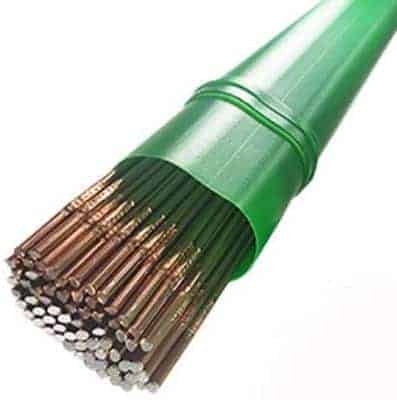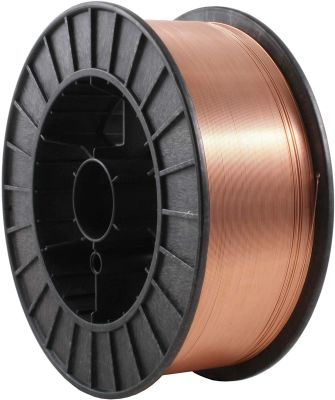In Brief: ER70S2 VS ER70S6
The ER70S2 and ER70S6 are both MIG and TIG compatible rods that can be used for all light-duty welding applications like sheet and pipe metal jobs. The wires are nearly identical in specifications save for the ER70S6 being better in yield and tensile strengths. The higher level of silicon in the ER70S6 can make the filler metal slightly more fluid than others and seems to float oxides to the surface, providing better welds on obstructive surfaces.
Welding wires are metallic rods which are used to generate a heated arc for joining two metal jobs together.
Welding wires can be of different types which are used for a variety of welding processes.
The wires are gas-shielded electrodes with a number of mechanical and chemical properties, arc behavior, quality, and cost.
The three main types of welding wires are –
- Solid gas metal arc welding (GMAW) wire
- Composite GMAW (metal-cored) wire
- Gas-shielded flux-cored arc welding (FCAW) wire
Wires also come in various diameters, which are usually selected on the basis of the welder being used and the material of the job.
The following sections will provide essential information on both the products.
Overview of ER70S2
The Lincoln ER70S-2 welding wire is triple deoxidized wire containing zirconium, titanium, and aluminum along with silicon and manganese.
The wire can be used for TIG as well as MIG welding processes.
The wire is also compatible to be utilized in all welding positions. ER70S2 can be used to obtain x-ray quality of welds over a majority of surfaces.
The wire can also be implemented in Post Weld Heat Treatment operations.
It is capable of exceeding 482 MPa (70 ksi) tensile and 400 MPa (58 ksi) yield strength after 8 hours of stress-relieving at 590 – 620 °C (1100 – 1150 °F).
The product is also marked at every 4 inches of length with AWS classification and LOT number for the identification of the specific product on hand.
The following video shows the product in use:
Pros
- Can be used on MIG as well as TIG welds
- Good yield and tensile strength
- High density
- Low splatter
- Inkjet printing identification on the entire length
Limitations
- Struggles to weld contaminated surfaces
The wire is typically used for repairs on mild or low alloy steels.
The Lincoln ER70S-2 is most often used for root pass pipe welding, sheet metal welding, smaller diameter pipes and tubing and commercial and light industrial repair of light-duty materials.
The wire has also found its uses in nuclear power plant construction and maintenance.
Overview of ER70S6
The ER70S6 is a general-purpose welding wire used for various fabrication jobs usually on mild steel. The wire contains more deoxidizers than other welding wires in its categories.
The product is usually compatible with 75:25 portion of argon and carbon dioxide shielding gas. The wire can also be used with 100% carbon dioxide or higher percentages of argon.
The welder facilitates more puddle fluidity and excellent wetting action which results in better-looking welding processes.
The welder has a tensile strength ranging from 80,000 to 90,000 and yield strength stretching from 65,000 to 75,000 psi, both of the discussed parameters are subject to the gases and composition used.
The product also contains high levels of silicon and manganese and an inkjet printing identification on entire
Pros
- Can be used on MIG as well as TIG welds
- More puddle fluidity
- Excellent wetting action
- Can Weld contaminated or rusted surfaces
- Good yield and tensile strength
Limitations
- More expensive than some of its counterparts
The wire is utilized primarily for a single pass on material surfaces where rust and contaminants are prevalent before the welding process. The higher levels of manganese and silicon deoxidizers make
The wire tolerates medium to heavy mill scale surfaces.
The ER70S6 is suitable for repairs on mild and low alloy steel, light-duty piping and tubing, various sheet metal applications and root pass pipe welding.
Key Differences between ER70S2 vs ER70S6
Both ER70S2 and ER70S6 can be used for MIG as well as TIG welding.
While similar in density, the wires are disparate in terms of tensile and yield strength.
The ER70S6 edges the ER70S2 in both yield and tensile strength, making it slightly more durable. Here is a quick table summarizing the differences –
| Wire | ER70S2 | ER70S6 |
|---|---|---|
| Tensile Strength | 78,000 psi | 80,000 – 90,000 psi |
| Yield Strength | 60,000 psi | 65,000 – 75,000 psi |
| Density | 0.283 lbs/in3 | 0.283 lbs/in3 |
| Price Range | Low | High |
| Processes Supported | MIG, TIG | MIG, TIG |
| Use on rusted/contaminated surfaces | No | Yes |
Summary
The wires both offer the same functionality, both being used for the same purpose of either MIG or TIG welding.
The ER70S6 offers more tensile and yield strength, albeit at a slightly increased cost. Both the wires can be used for similar jobs due to identical capabilities.
The major difference between the two products is prominent when the user is operating on contaminated or rusted surfaces, in which case the ER70S6 provides better penetration and higher quality of welds.
The additional deoxidizers present in the ER70S6 provide better wetting, giving a flatter bead shape and the capability of faster travel speeds.
This is due to the higher prevalence of silicone in ER70S6 than ER70S2, the number at the end of the product name (-2 or -6) signifies the amount of the silicon present in the welding wire.


